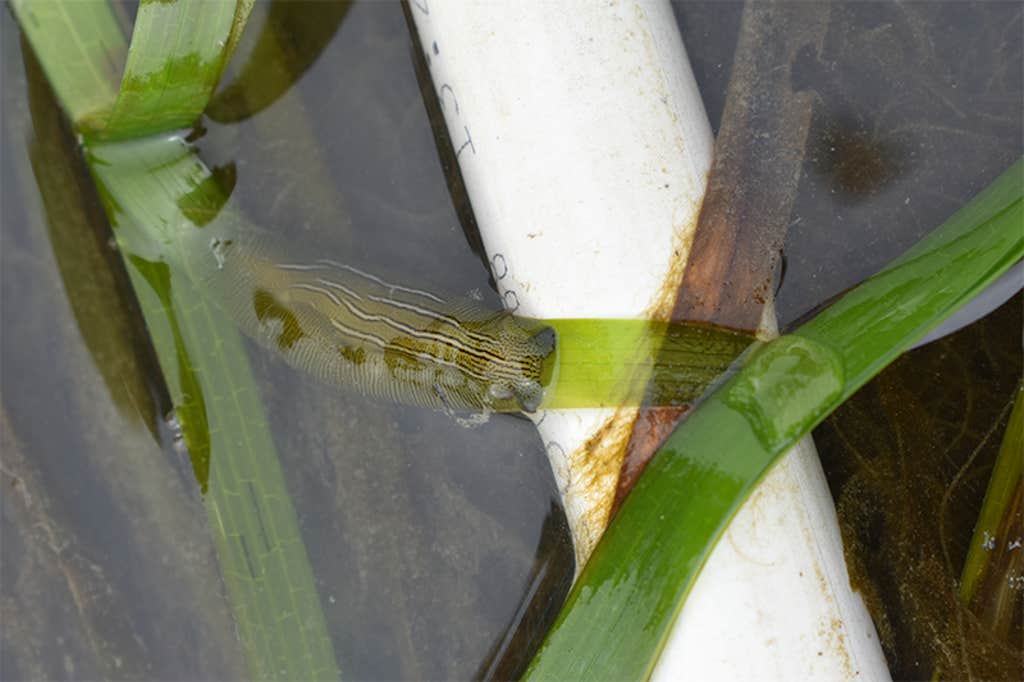Scouring for sea slugs by combing through long seagrass blades is not easy, according to Richelle Tanner, a marine ecologist at Chapman University in Orange, California. She has to blindly but carefully run her hands along the entire plant, pressing lightly, to pick out the species she studies, Taylor’s sea hare (Phyllaplysia taylori). “You’re at the mercy of whether you can feel a tiny little lump in the grass,” says Tanner.
The sea slugs, also called sea hares because of bunny-ear-like protrusions on their heads, blend into the seagrass they live on because of how they look—like little blobs of translucent green with white stripes.
But the camouflaged invertebrates are immensely important for seagrass survival. Warming waters and nutrient runoff can spur algae to overgrow and suffocate seagrasses. But the sea hares traverse plant leaves dining on these harmful algae. “The sea hare is my favorite animal, because they are like these little lawn mowers—they eat all the algae that are growing on seagrass, keeping it clean and allowing it to photosynthesize,” says Brent Hughes, a marine ecologist at Sonoma State University.
And now, Tanner and her collaborators have found that the Taylor’s sea hare may even be able to withstand climate change, at least to a point.
Human activities and climate change are shrinking once-lush seagrass meadows across the globe.
In a recent study published in Ecosphere, Tanner and her colleagues discovered that the sea hares are remarkably resilient to changes in temperature, capable of tolerating maximum temperatures varying from 24 to 35 degrees Celsius. Surface water temperatures off the Pacific Coast of the U.S. average around 11 to 14 degrees Celsius, but climate models predict that ocean water temperatures will increase by 1.2 to 3.2 degrees Celsius by 2100.
The researchers also found that none of the 11 different Taylor’s sea hare populations they sampled along the western United States coast were genetically distinct. Sea hares from near Washington State in the north to Morro Bay in central California all showed high levels of genetic diversity and seemed to be part of one big, well-mixed population. Both their ability to tolerate high temperatures and their inherent genetic diversity could make them key allies in seagrass restoration efforts, especially as ocean waters continue to warm.
Seagrasses—tall, swaying, grass-like aquatic plants—are crucial marine environments. They store coastal carbon, provide a home for various sea creatures, reduce ocean acidification, and protect shorelines from destructive waves. Human activities and climate change are shrinking once-lush seagrass meadows across the globe, with algal overgrowth being one reason for the losses. Given their role in protecting seagrass from being overrun by algal blooms, Tanner says she wanted to see how a changing climate could potentially affect sea hares and their unique relationship with eelgrass—a type of seagrass.

To test the sea hares’ tolerance to higher temperatures, Tanner and her team first exposed individuals from the 11 populations to three different temperatures in the lab—13 degrees Celsius, 17 degrees Celsius, and 21 degrees Celsius—for two to three weeks. Animals held at higher temperatures were more capable of tolerating high temperature shocks, up to 35 degrees Celsius.
But the temperatures of the waters they grew up in—their habitat temperatures—seemed to have no effect on the sea hares’ ability to tolerate high temperatures shocks. Neither the location of their population off the U.S. West Coast nor their underlying genes seemed to affect the maximum temperatures they could tolerate in the lab. This means that the sea hares’ brief laboratory conditioning was more important than adaptations they accrued over generations to modulating their impressive temperature tolerance.
“An animal could evolve to have responses up to a certain temperature, because that’s the highest temperature they’ve ever seen in the last 100 generations,” Tanner says. “This animal does not have that. We did not find an evolutionary basis for how it sets the highest temperature that it can withstand and maintain its function.” Tanner suggests that the sea slugs have some sort of thermal tolerance plasticity, drawing a comparison to how humans acclimatize, to a lesser extent, to different seasons.
The Taylor’s sea hare may even be able to withstand climate change, at least to a point.
“During the winter you get a little bit more used to it being cold, and you might not have to wear as many sweaters as you would if you experienced that same cold temperature during the summer,” Tanner explains. “If we acclimate [the sea hares] to different temperatures, they can raise the maximum temperature that they can withstand.”
The high genetic diversity among the geographically distinct sea slug populations was also unexpected. Unlike many other marine invertebrates, these sea hares don’t have a larval stage that can swim freely out into the ocean and intermingle with individuals from different populations. “A lot of my work has been looking at how organisms, at the physiological level, deal with the stress of a world that is changing. But it was really immediately the genetics that surprised me,” says Scott Applebaum, a developmental physiologist at University of Southern California. “These things are supposed to just disperse a fairly short distance, but the mix of genetics up and down the coast says that there’s a lot more exchange than we anticipated.”
Tanner’s hypothesis is that Taylor’s sea hares hitch a ride on the seagrasses themselves, doing something called “rafting.” Sometimes seagrasses can get physically uprooted because of storms or other disturbances, and they can travel with the ocean currents from one bay into another. The sea hares may go along for the ride and mate with individuals from distant populations in this way.
Hughes believes that learning how much heat the sea hares can withstand is an important step in managing seagrass ecosystems coping with a changing climate. “Moving forward, when doing restoration, we should consider how hot these organisms can get right before they die,” says Hughes. “Because if the area gets too hot, then maybe it’s not a good idea to plant seagrass [there]. If the organisms, not just the seagrass, can’t tolerate those conditions.” ![]()
Lead image: Richelle Tanner
































